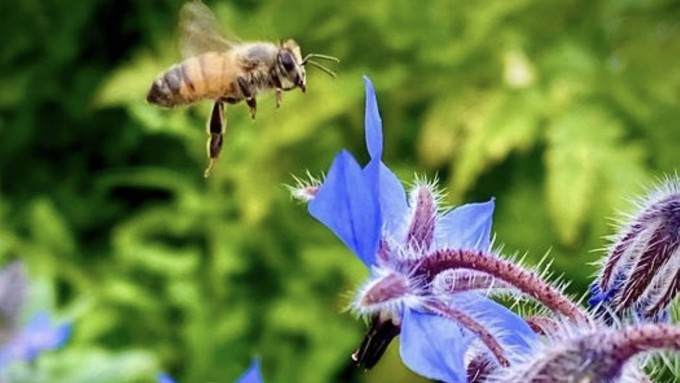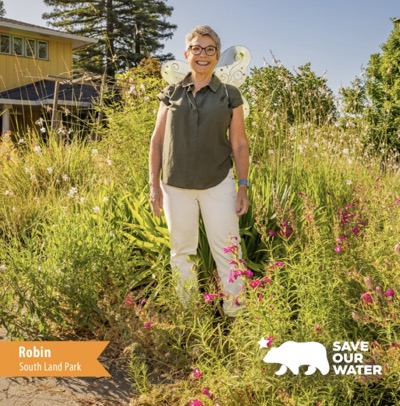
Summer Strong Yard winner makes wildlife a priority

Robin Netzer created the pollinator garden of her dreams after losing two trees. Now it buzzes with bees and other insects. Courtesy Robin Netzer
Robin Netzer had thought about making over her South Land Park for years. The loss of two trees in 2012 prompted her to finally take action.
“The removal of two old and dying liquid amber trees was the final straw for installing a pollinators landscape,” recalls the Sacramento artist and master gardener. “I was heavily influenced by other gardeners and gardens, Mendocino, Wine Country gardens and English landscapes. I’m heavily influenced by different painters’ landscapes such as Japanese screens, Klimt and Van Gogh.”
With a new sunny space to work with, Netzer created the pollinator garden of her dreams.

“Its focus has been as a habitat for pollinators,” she says. “The joy has been a bounty of beauty. … I love the changing tapestry of flowers, leaves, bees, butterflies and insects.”
For her efforts and for providing inspiration to others, Netzer was recently honored as a “Summer Strong Yard” winner by the Regional Water Authority. Her garden and its story are featured on https://bewatersmart.info/.
Netzer and husband Mark Paul have lived in their Sacramento home for many years. Their sloped and oddly shaped lot was a challenging space to landscape and irrigate; water wanted to flow off, not soak in.
By putting the right plants in the right place, Netzer added bold and bright color as well as reduced water use.
“We’ve seen a 20% to 50% decrease in annual water use, depending on whether it’s been a dry or rainy year,” she says.
Her water-wise landscape features many eye-catching plants such as a desert willow, California and Shirley poppies plus matilija poppies (“crepe paper white crowned with a fluff of yellow stamens”), a giant ‘Pride of Madeira’ echium and an oakleaf hydrangea that provides multiple seasons of color.
“Always try seeds in the fall for a crazy and bountiful spring,” she says.
Netzer got expert help in her redesign. “I have done a lot of the work but Joel Brungardt (of Brungardt Landscaping in Davis) was instrumental in irrigation and streamlining much of the new planting, terracing and assembling vegetable garden boxes.”
Total cost was less than $3,700 in 2012 without rebates. Current rebates from the City of Sacramento could have lowered that cost even more.
During the summer, Netzer focuses on her trees.
“I take special care to water my trees,” she says. “I water early in the morning and use a moisture meter to check soil moisture.”
Her advice for other gardeners thinking about a pollinator garden?
“Do your research but – remember – to take time to enjoy the process; everything from dirt piles to finishes,” Netzer says. “Install irrigation if you can and mulch, mulch, mulch. There’s never enough plants nor time; enjoy it.”
Comments
0 comments have been posted.Sacramento Digs Gardening to your inbox.
Food in My Back Yard Series
May 6: Maintain soil moisture with mulch for garden success
April 29: What's (already) wrong with my tomato plants?
April 22: Should you stock up on fertilizer? (Yes!)
April 15: Grow culinary herbs in containers
April 8: When to plant summer vegetables
April 1: Don't be fooled by these garden myths
March 25: Fertilizer tips: How to 'feed' your vegetables for healthy growth
March 18: Time to give vegetable seedlings some more space
March 11: Ways to win the fight against weeds
March 4: Potatoes from the garden
Feb. 25: Plant a fruit tree now -- for later
Feb. 18: How to squeeze more food into less space
Feb. 11: When to plant? Consider staggering your transplants
Feb. 4: Starting in seed starting
Sites We Like
Garden Checklist for week of May 4
Enjoy this spring weather – and get gardening!
* Plant, plant, plant! It’s prime planting season in the Sacramento area. Time to set out those tomato transplants along with peppers and eggplants. Pinch off any flowers on new transplants to make them concentrate on establishing roots instead of setting premature fruit.
* Direct-seed melons, cucumbers, summer squash, corn, radishes, pumpkins and annual herbs such as basil.
* Harvest cabbage, lettuce, peas and green onions.
* In the flower garden, direct-seed sunflowers, cosmos, salvia, zinnias, marigolds, celosia and asters. (You also can transplant seedlings for many of the same flowers.)
* Plant dahlia tubers. Other perennials to set out include verbena, coreopsis, coneflower and astilbe.
* Transplant petunias, marigolds and perennial flowers such as astilbe, columbine, coneflowers, coreopsis, dahlias, rudbeckia and verbena.
* Keep an eye out for slugs, snails, earwigs and aphids that want to dine on tender new growth.
* Feed summer bloomers with a balanced fertilizer.
* For continued bloom, cut off spent flowers on roses as well as other flowering plants.
* Add mulch to the garden to maintain moisture. Mulch also cuts down on weeds. But don’t let it mound around the stems or trunks of trees or shrubs. Leave about a 6-inch to 1-foot circle to avoid crown rot or other problems.